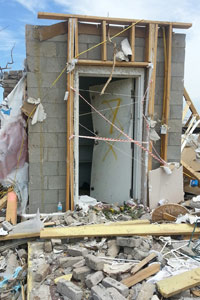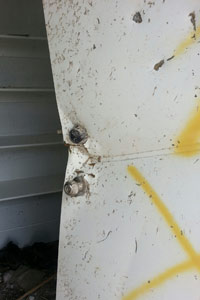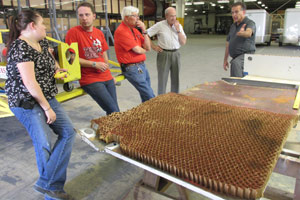
A violent EF-4 tornado in Mayflower and Vilonia, Arkansas on April 27, 2014 killed a total of twelve people, but one of those fatalities came inside a storm shelter in the City of Mayflower.
From Analysis of the Above Ground Shelter Door Failure April 27, 2014 Tornado, Mayflower, Arkansas
Larry J. Tanner and Ernst W. Kiesling
Larry J. Tanner and Ernst W. Kiesling
“Multi-story homes were destroyed or damaged and concrete road barriers were moved and overturned. Given these Damage Indicators and Degrees of Damage, the NWS rated the storm an EF-4 with winds estimated at 166-200 mph (267-322 km/h). (Wikipedia.org)
One death in Mayflower occurred when the storm door on the home above ground residential shelter was impacted by storm debris. According to the surviving homeowner, all three dead bolts were engaged initially. A missile of unknown weight and speed struck the center of the door which resulted in the door bending and failure of the center dead bolt and the shearing of the top dead bolt leading to the death of one of two occupants.”
 The conclusion of the Texas Tech investigation is this: “It therefore appears that the door was not impacted by some astronomical object traveling at a high rate of speed. Door failure resulted from the improper usage of a door, frame, and hardware not intended for tornado safe rooms. Just because it was steel door did not qualify it to be a tornado safe room door.
The conclusion of the Texas Tech investigation is this: “It therefore appears that the door was not impacted by some astronomical object traveling at a high rate of speed. Door failure resulted from the improper usage of a door, frame, and hardware not intended for tornado safe rooms. Just because it was steel door did not qualify it to be a tornado safe room door.This tragedy highlights the dangers of the deviation from tested FEMA P-320 door assemblies.”
Read the entire report here: Texas Tech University Storm Shelter Analysis
Analysis of the Above Ground Shelter Door Failure April 27, 2014 Tornado, Mayflower, Arkansas
Larry J. Tanner and Ernst W. Kiesling
Larry J. Tanner and Ernst W. Kiesling
I see new homes going up every day in Huntsville, and many of them have above-ground storm shelters (safe rooms) added to the plans at the time of construction. This is a good thing, but the safe room has to be built the right way! How do you know what’s right? Keep reading.
There are guidelines builders should be using to construct shelters, but I’m of the opinion that you should look at professionally-built shelters from reputable companies that can show proof of how their shelters fare in violent winds. I’m not knocking our contractors around here, but this is your family’s safety we’re talking about here!
 FEMA P-320 standards should be applied to all above ground shelters. What is FEMA P-320? It “provides safe room designs that will show you and your builder/contractor how to construct a safe room for your home or small business. Design options include safe rooms located underneath, in the basement, in the garage, or in an interior room of a new home or small business. Other options also provide guidance on how to modify an existing home or small business to add a safe room in one of these areas. These safe rooms are designed to provide near-absolute protection for you, your family, or employees from the extreme winds expected during tornadoes and hurricanes and from flying debris, such as wood studs, that tornadoes and hurricanes usually create.”
FEMA P-320 standards should be applied to all above ground shelters. What is FEMA P-320? It “provides safe room designs that will show you and your builder/contractor how to construct a safe room for your home or small business. Design options include safe rooms located underneath, in the basement, in the garage, or in an interior room of a new home or small business. Other options also provide guidance on how to modify an existing home or small business to add a safe room in one of these areas. These safe rooms are designed to provide near-absolute protection for you, your family, or employees from the extreme winds expected during tornadoes and hurricanes and from flying debris, such as wood studs, that tornadoes and hurricanes usually create.”
See all of FEMA P-320 online at FEMA.gov, and if you are considering a safe room/above-ground storm shelter in your home, make sure the builder follows the guidelines.
-Jason
Connect with me!
Google+: Jason Simpson
Facebook: Jason Simpson’s Fan Page
Twitter: @simpsonwhnt
Connect with me!
Google+: Jason Simpson
Facebook: Jason Simpson’s Fan Page
Twitter: @simpsonwhnt
~~~~~~~~~~~~~~~~~~~~~
They remind consumers to trust only those building materials tested to withstand high tornadic winds.

This door attached to an above-ground shelter failed during an EF-4 tornado in Arkansas on April 27, resulting in one death.
When building an above-ground storm shelter, or any shelter for that matter, make sure building materials are rated to withstand high tornadic winds and the onslaught of debris those winds can bring.
Especially when it comes to selecting doors.
That’s the tragic take-home message two Texas Tech University wind researchers want homeowners to receive after completing forensic testing on a door that failed earlier this year during a tornado in Mayflower and Vilonia, Arkansas. The April 27 EF-4 twister generated winds estimated at 166-200 mph that took the life of one person inside the above-ground shelter and 12 total.
In Phase I of the project, researchers at Texas Tech took the door apart and discovered that, while the door was well-built, it wasn’t intended for storm-shelter application, prompting scientists to wonder how many other storm shelters may be equally unequipped. The forensic work performed on the door was witnessed by experts in the door and hardware industry.
“The door is a critical component of an above ground storm shelter and also an expensive component,” said Ernst Kiesling, research professor at Texas Tech’s National Wind Institute (NWI) and executive director of the National Storm Shelter Association (NSSA). “To be effective, the door must be able to withstand wind-induced pressures as well as windborne debris. Hardware including latches, hinges and deadbolts must also be chosen carefully to assure reliability in storm shelter applications. The entire door system, including frame and hardware, should be proven by testing to be appropriate for storm shelter application.”

A closer view of the door in question.
Creating the Safest Shelter Possible
The NSSA currently is working with Kiesling and Larry Tanner, a research assistant professor at the NWI, at the Debris Impact Test Facility at Texas Tech. There, scientists hope to address a serious problem in the storm shelter industry: installing substandard, untested doors in above-ground, site-built storm shelters.
Tanner, who also manages the Debris Impact Facility, said Texas Tech has been involved in the development of above-ground storm shelters since the early 1970s when the concept was introduced by Texas Tech researchers. The NSSA came into being in 2000 and has as its primary purpose the fostering of quality in the storm shelter industry.
Retail prices of residential size doors vary widely, he said. Also, doors look similar, making it difficult to distinguish the suitable door for storm shelter application from the unsuitable.
“Members of NSSA were able to secure the door and deliver it to our laboratory,” Tanner said. “We knew immediately upon seeing the actual door that it was an untested unit. This door was not manufactured for storm resistance, but rather for general home security. Tornado door assemblies (door, frame and hardware) are tested to resist wind pressures and debris impacts from an EF 5 ground speed tornado of 250 mph. These are the FEMA P320/P361 and ICC/NSSA-500 criteria. Parts are not interchangeable. Each proposed assembly by the manufacturer or supplier, must be tested for resistance to the criteria.”
Putting Things in Perspective
The death of the person in Arkansas is a wake-up call for the storm shelter industry, Kiesling said, and hopefully the industry now is receptive to reliable information supported by professional demonstration.

A view of the door after it was dissected by Texas Tech researchers.
In Phase II of the project, Texas Tech researchers will use a state-of-the-art debris launcher and high-speed photography equipment to characterize and demonstrate the failure mechanism of doors that are unable to carry tornado-induced wind pressures and debris impacts. They also will show successful performances.
Finally, in Phase III, researchers will develop strategies and hardware to modify untested, substandard doors that have been installed that lead users to a false sense of security. Results will be made available to the public, hopefully informing users of the importance of using tested doors for storm shelter applications.
“In talking with industry representatives, we learn that the practice is rather widespread in constructing above-ground storm shelters to use lightweight, relatively inexpensive doors,” Kiesling said. “We hope to add clarity to the availability and selection process for shelter doors. Results will be reported in professional publications, presentations and through the media.”
////////

I precisely needed to appreciate you once again. I am not sure the things I could possibly have achieved without these basics provided by you relating to this subject. Completely was a traumatic setting in my position, however , considering a well-written form you processed it forced me to jump over delight. I am just happy for the service and even pray you know what a great job you are always doing training other individuals using your site. Most likely you have never met all of us. residential shelter
ReplyDelete